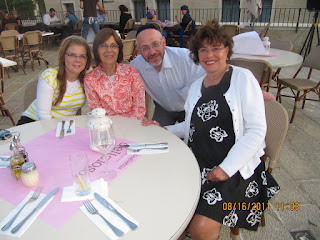"And to them will I give in my house and within my walls a memorial and a name (a "yad vashem")... that shall not be cut off."
(Isaiah, chapter 56, verse 5)
As the Jewish people’s living memorial to the Holocaust, Yad Vashem safeguards the memory of the past and imparts its meaning for future generations. Established in 1953, as the world center for documentation, research, education and commemoration of the Holocaust, Yad Vashem is today a dynamic and vital place of intergenerational and international encounter.
For over half a century, Yad Vashem has been committed to four pillars of remembrance:
The woman I am in the picture with- this museum means a lot to her - Her both parents survived the holocaust in concentration camps - finding each other when the camps were liberated. Their sons were killed but they both lived and now she is here in Israel with her family and we are going to a wedding of her youngest son Ben.
Our next stop today was the Tunnels under the Western Wall The Western Wall Tunnel (Hebrew: מנהרת הכותל, translit.: Minheret Hakotel) is an underground tunnel exposing the full length of theWestern Wall. The tunnel is adjacent to the Western Wall and is located under buildings of the Old City of Jerusalem, Israel. While the open-air portion of the Western Wall is approximately 60 metres (200 ft) long, the majority of its original length is hidden underground. The tunnel allows access to an additional 485 metres (1,591 ft) of the wall.
The tunnel exposes a total length of 485 m of the wall, revealing the methods of construction and the various activities in the vicinity of the Temple Mount.[1] The excavations included many archaeological finds along the way, including discoveries from the Herodian period (streets, monumental masonry), sections of a reconstruction of the Western Wall dating to the Umayyad period, and various structures dating to the Ayyubid, Mamluke and Hasmonean periods constructed to support buildings in the vicinity of the Temple Mount.
"Warren's Gate" lies about 150 feet (46 m) into the tunnel. This sealed-off entrance has been turned into a small synagogue called "The Cave", by Rabbi Yehuda Getz, since it is the closest point a Jew can get to the Holy of Holies, assuming it was located at the traditional site under the Dome of the Rock.
At the northern portion of the Western Wall, remains of a water channel, which originally supplied water to the Temple Mount, were found. The exact source of the channel is unknown, though it passes through an underground pool known as the "Struthion Pool". The water channel was dated to the Hasmonean period and was accordingly dubbed the "Hasmonean Channel".
The biggest stone in the Western Wall often called the Western Stone is also revealed within the tunnel and ranks as one of the heaviest objects ever lifted by human beings without powered machinery. The stone has a length of 13.6 metres (45 ft) and an estimated width of between 3.5 metres (11 ft) and 4.5 metres (15 ft); estimates place its weight at 570 short tons (510 long tons).
Adjacent to the tunnel lies a museum called "The Chain of Generations Center," designed by Eliav Nahlieli. The Center, which incorporates ancient and modern Jewish history, includes an audiovisual show, and nine glass sculptures created by glass artist Jeremy Langford.
In 2007 the Israel Antiquities Authority uncovered an ancient Roman street, thought to be from the second to fourth centuries. It was a side street which likely connected two major roads, and led up to the Temple Mount. The discovery of the road gave further evidence that Romans continued to use the Temple Mount after the destruction of the temple in 70 CE.[5]
Tonight we had a family dinner with relatives of Marilyn's who moved here from the US nine years ago - tomorrow we are heading South for the wedding we will be visiting the Dead Sea on the way.







When Ellen and I travel great distances we find the best times are those spent with friends who live there. Plus, their local knowledge is invaluable and makes the experience that much richer. Continued safe travels, Marilyn and Bruce. Marc and Ellen
ReplyDelete